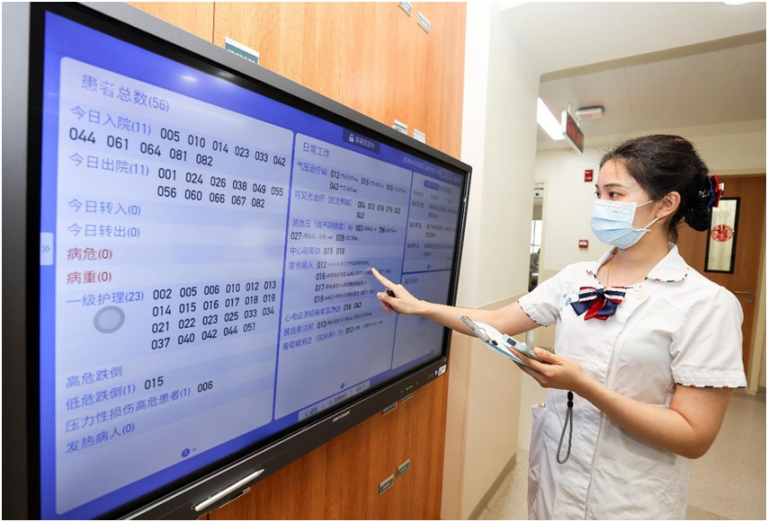
By Zheng Yi, People’s Daily
From establishing online hospital platforms, to launching surgical robots, and to building intelligent pharmacies, efforts have been made across China over the recent years to enrich the application scenarios of smart hospitals, with an aim to bring better medical services to the people.
The intelligent transition of the Liuzhou Worker’s Hospital in Liuzhou, south China’s Guangxi Zhuang autonomous region is a great example.
Li Fangfang recently had her first-ever hospital visit to the Liuzhou Worker’s Hospital. When she just arrived there, she opened on her mobile phone an in-hospital navigation mini program developed by the hospital and was soon guided to the cardiovascular department, the department she had registered for.
“It’s so convenient. I’ll never go the wrong way though the hospital is big,” Li said.
After entering the consulting room, Li explained her symptoms to cardiologist Xia Meng. “My chest has been feeling tight lately, and I don’t know why,” she told Xia.
Though Li had never been to the Liuzhou Worker’s Hospital, all of the medical images she had at other hospitals in Liuzhou were available to Xia.
According to Xia, the Liuzhou Worker’s Hospital was connected to a cloud platform launched by Liuzhou on April 1 this year, which records all diagnostic test results and case history of registered patients.

A nurse of the inpatient department of the Liuzhou Worker’s Hospital, south China’s Guangxi Zhuang autonomous region, takes out medicines from a logistics robot. (Photo by Chen Xinyuan)
Doctors can also obtain patients’ ultrasound images, pathology images and magnetic resonance images, Xia told People’s Daily, adding that patients don’t have to take physical images with them when going to hospital, which is more convenient.
“Open the mini program of the hospital, pay on your phone and then you can get your prescription filled at the pharmacy,” Xia told Li after the diagnosis was over.
When Li arrived at the pharmacy, she saw two prescription vending machines loaded with various types of medicines.
“After patients pay the fees, their prescriptions will be transferred to the pharmacy. Then we print and scan the bar codes that carry their information, and the prescription will be automatically filled by the machines,” said Shi Yedui, associate chief pharmacist of the hospital’s department of pharmacy.
When Li was about to leave the hospital, a volunteer reminded her that she could consult doctors on the mini program if she had any questions about her illness and medication.
“It’s great to get free consultation with doctors anytime I want,” Li said.
At 9:00 am, there were many patients waiting to get blood tests at the clinical lab on the second floor of the outpatient building of the Liuzhou Worker’s Hospital.
“From drawing to sorting blood samples, we are assisted by automatic devices,” Wu Hao, chief technician of the clinical lab, told People’s Daily.

A nurse on duty at the Liuzhou Worker’s Hospital, south China’s Guangxi Zhuang autonomous region, checks the information of patients. (Photo by Chen Xinyuan)
According to him, after a technician scans the QR code of a patient, an empty test tube with a barcode would pop out, and all the technician needs to do is to take the sample and put it onto a conveyor belt.
The conveyor would then carry the tube to the lab, where the blood sample is classified according to specific test requirements by a full-automatic system for mass spectrometry for the identification of microorganisms, Wu said.
The automatic system cuts the time of blood sampling by 40 percent to 50 percent, and is nearly twice as fast as manual operations.
Automatic devices are also widely applied in operating rooms. At around 7:00 pm, Wu Dongbo, director of the Inpatient Ward No.1 of the hospital’s general surgery department was performing a resection surgery with the assistance from a surgical robot. A robotic arm was seen moving near the operating table, while Wu was controlling the robotic arm at a control center 5 meters away from the patient.
“The surgical robot is capable of magnifying images 40 times at most, which provides clearer visions and thus makes surgeons more decisive,” said Zhang Yanzhuo, director of the anesthesiology department, adding that the robot can also significantly reduce the time of operation as it has higher limits than human hands.
Deputy chief nurse of the anesthesiology department’s operating room Liao Liwen told People’s Daily that families of patients can track the progress of surgeries on the hospital’s mini program. The operating room is also cyber-connected to the inpatient building, so that the departments where patients are registered can obtain first-hand information, Liao added.
Besides, the Liuzhou Worker’s Hospital also employs an intelligent logistics system to send medicines, specimens and consumables between departments. The system has 41 stations, and it takes about only six minutes for each run on average. It has carried a total of over 450,000 boxes since being put into use, or 485 per day averagely, significantly improving the efficiency of in-hospital logistics.
“In the future, we’ll further utilize artificial intelligence, cloud computing and other technologies to build a big data center with clinical medicine, scientific research and commercial operation at the core, so as to provide better, more efficient and more convenient medical services for patients,” said Huang Haixin, president of the Liuzhou Worker’s Hospital.










